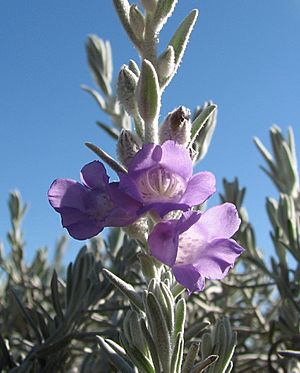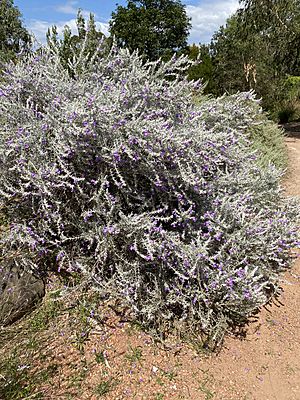Silky eremophila facts for kids
Quick facts for kids Silky eremophila |
|
|---|---|
 |
|
| Eremophila nivea in Royal Botanic Gardens, Cranbourne | |
| Conservation status | |
| Scientific classification | |
| Genus: |
Eremophila (plant)
|
| Species: |
nivea
|
The Eremophila nivea, often called silky eremophila, is a beautiful flowering plant. It belongs to the figwort family, which is known as Scrophulariaceae. This plant is special because it is found only in Western Australia. In nature, it is a rare shrub. It has soft, hairy branches and leaves. Its flowers can be blue, purple, or violet.
Contents
What Does Silky Eremophila Look Like?
The silky eremophila is a shrub that stands upright. It usually grows to be about 0.8 to 1.6 meters (around 2.5 to 5 feet) tall. Its branches, leaves, and the small leaf-like parts under its flowers, called sepals, are covered in soft, white or grayish hairs. This makes the whole plant look silvery-gray.
The leaves grow one after another along the branches. They are long and thin, usually 8 to 18 millimeters (about 0.3 to 0.7 inches) long. They are also covered in woolly hairs.
The Flowers of Silky Eremophila
The flowers grow either alone or in pairs where the leaves meet the stem. They sit on woolly stalks that are 2 to 5.5 millimeters long. Each flower has five sepals that overlap. These sepals are shaped like triangles and are 14 to 21 millimeters long. They have dark purplish-black tips.
The petals of the flower are 15 to 23 millimeters long. They join together at the bottom to form a tube shape. This tube is a pretty lilac color. Inside, it is white with yellow-brown spots. The outside of the tube and the ends of the petals are smooth, without hairs. But the inside of the tube is full of long, soft hairs. The flower has four stamens, which are the parts that make pollen. These stamens are completely hidden inside the petal tube.
Silky eremophila flowers bloom from August to October. After the flowers, the plant produces dry, woody fruits. These fruits are oval-shaped with a pointed end and are about 4.5 to 6 millimeters long.
How Silky Eremophila Got Its Name
This plant was officially described in 1986 by a botanist named Robert Chinnock. He published his description in a scientific journal called Nuytsia.
The second part of its scientific name, nivea, comes from a Latin word. It means "snowy" or "snow-white." This name was chosen because of the white hairs that cover the plant's branches and leaves, making it look like it's covered in snow.
Where Silky Eremophila Grows
In the wild, Eremophila nivea is only found in a few places. These areas are near Three Springs in Western Australia. It grows in sandy clay and clay-loam soils.
There are only a few groups of these plants left. Some of them grow along the sides of roads. This can be a bit risky for them because of road work.
Protecting Silky Eremophila
Because it is so rare, the silky eremophila is considered a "Threatened Flora" species. This means it is a plant that needs special protection. The Department of Environment and Conservation (Western Australia) has even created a plan to help it recover. This plan aims to protect the existing plants and help new ones grow.
Growing Silky Eremophila in Gardens
Even though it's rare in nature, silky eremophila is quite popular in plant nurseries. People love its soft, silvery-gray leaves and its beautiful blue flowers. Sometimes, you can even find a version with white flowers.
You can grow new silky eremophila plants in a few ways. One way is by taking small pieces of the plant, called cuttings, and helping them grow roots. Another way is by grafting it. This means joining a piece of silky eremophila onto the root system of another plant, like a Myoporum. Gardeners have different ideas about which method works best.
This plant can grow in most types of soil. It can handle both dry weather and cold temperatures (frost). It needs to be grown in a sunny spot. To keep it looking good and healthy, it's a good idea to trim it regularly after it finishes flowering. This also helps prevent plant diseases.



